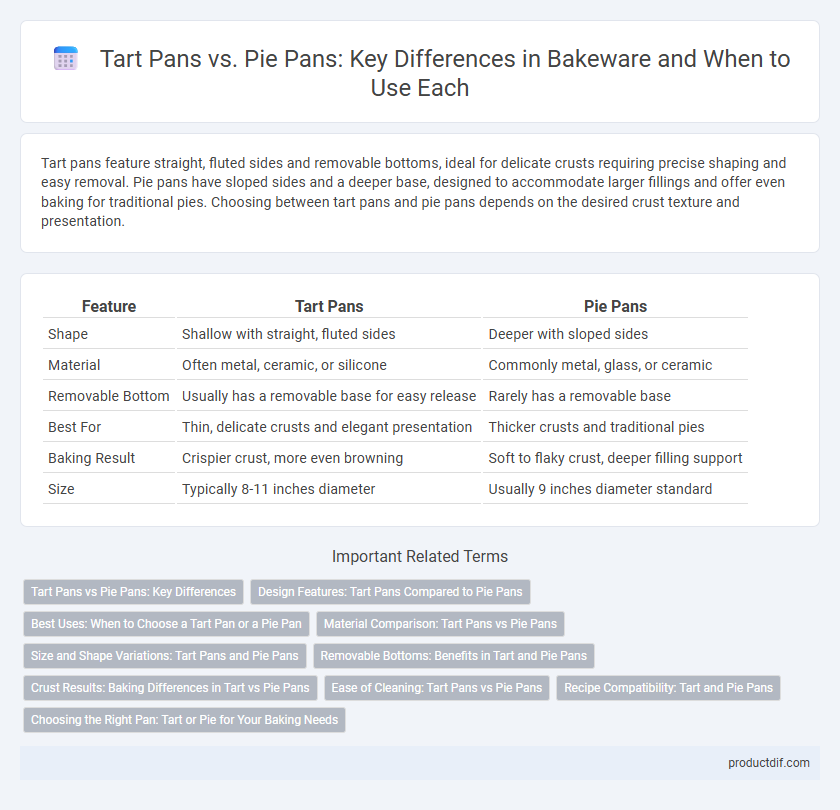Tart pans feature straight, fluted sides and removable bottoms, ideal for delicate crusts requiring precise shaping and easy removal. Pie pans have sloped sides and a deeper base, designed to accommodate larger fillings and offer even baking for traditional pies. Choosing between tart pans and pie pans depends on the desired crust texture and presentation.
Table of Comparison
| Feature | Tart Pans | Pie Pans |
|---|---|---|
| Shape | Shallow with straight, fluted sides | Deeper with sloped sides |
| Material | Often metal, ceramic, or silicone | Commonly metal, glass, or ceramic |
| Removable Bottom | Usually has a removable base for easy release | Rarely has a removable base |
| Best For | Thin, delicate crusts and elegant presentation | Thicker crusts and traditional pies |
| Baking Result | Crispier crust, more even browning | Soft to flaky crust, deeper filling support |
| Size | Typically 8-11 inches diameter | Usually 9 inches diameter standard |
Tart Pans vs Pie Pans: Key Differences
Tart pans feature straight, fluted edges and removable bottoms ideal for delicate crusts and intricate presentations, while pie pans have sloped sides and solid bases designed for sturdier, classic pies. The shallow depth of tart pans contrasts with the deeper structure of pie pans, affecting baking time and crust texture. Choosing between tart pans and pie pans depends on the desired dessert style, crust crispness, and ease of removal.
Design Features: Tart Pans Compared to Pie Pans
Tart pans feature straight, fluted sides and often come with a removable bottom for easy release, which distinguishes them from pie pans that typically have sloped, smooth edges and a fixed base. The rigid structure of tart pans supports delicate crusts, ensuring a crisp, evenly baked shell. Pie pans, designed for softer, thicker crusts, prioritize depth to accommodate fillings and support a more rustic presentation.
Best Uses: When to Choose a Tart Pan or a Pie Pan
Tart pans excel in creating desserts with delicate, crumbly crusts and intricate designs, ideal for fruit tarts or quiches that benefit from removable bottoms for easy serving. Pie pans are best for deep-dish pies with thick fillings like apple or pumpkin, offering sturdy rims for crimping dough and even heat distribution. Choose tart pans for precise presentation and thin crusts, while pie pans suit hearty, rustic pies requiring solid support.
Material Comparison: Tart Pans vs Pie Pans
Tart pans are typically made from materials like aluminum, non-stick coated steel, or silicone, which provide even heat distribution and easy release essential for delicate tarts. Pie pans often feature heavier gauge tin, glass, or ceramic materials that retain heat longer, resulting in a well-cooked, crisp crust but less flexibility in unmolding. Choosing between tart pans and pie pans depends on the desired crust texture and baking needs, with tart pans favoring precision and pie pans offering rustic sturdiness.
Size and Shape Variations: Tart Pans and Pie Pans
Tart pans typically feature straight, fluted sides and a removable bottom, offering precise edges for delicate crusts, with sizes ranging from 4 to 12 inches in diameter. Pie pans usually have sloped sides and a continuous rim, available in larger diameters up to 14 inches, accommodating deeper fillings. The distinct shapes influence crust thickness and baking dynamics, with tart pans providing a more uniform, thinner crust and pie pans allowing for thicker, more rustic crusts.
Removable Bottoms: Benefits in Tart and Pie Pans
Tart pans with removable bottoms offer easy release of delicate crusts without damaging intricate edges, enhancing presentation and reducing cleanup time. Pie pans, while often fixed-bottom, sometimes feature removable bases that simplify serving and maintain the integrity of larger, denser fillings. The removable bottom design is especially beneficial in professional baking, ensuring precise shapes and effortless removal for both tarts and pies.
Crust Results: Baking Differences in Tart vs Pie Pans
Tart pans, typically featuring straight, fluted sides and removable bottoms, promote even browning and crispier crusts by allowing heat to circulate more directly around the edges. Pie pans generally have sloped, softer sides which can lead to a thicker, chewier crust that retains more moisture. The depth and shape variation between tart and pie pans significantly affect crust texture, with tart pans delivering a flakier and more delicate crust ideal for showcasing fillings.
Ease of Cleaning: Tart Pans vs Pie Pans
Tart pans typically feature removable bottoms, making it easier to lift out delicate pastries and clean the pan thoroughly. Pie pans usually have fixed bottoms and deeper sides, which can trap crumbs and filling residues, requiring extra scrubbing during cleaning. Non-stick coatings on both tart and pie pans significantly reduce cleanup time by preventing food from sticking to the surface.
Recipe Compatibility: Tart and Pie Pans
Tart pans feature straight, fluted edges that create a crisp, elegant crust ideal for delicate fillings like custards and fruited tarts, while pie pans have sloped sides that support the rustic, flaky crusts typical of traditional pies and fruit fillings. Recipes with buttery, tender crusts and precise edges perform best in tart pans, whereas heartier, double-crust or lattice pies bake well in pie pans due to their depth and shape. Choosing the correct pan enhances texture and presentation, optimizing baking results for specific tart and pie recipes.
Choosing the Right Pan: Tart or Pie for Your Baking Needs
Tart pans feature straight, fluted sides and often come with removable bottoms, providing easy release and a crisp, decorative crust ideal for delicate pastries. Pie pans have sloped sides and are typically deeper, allowing for larger, more rustic fillings and a traditional pie shape with a thick crust edge for crimping. Selecting between tart and pie pans depends on the desired crust texture and presentation, with tart pans favored for precise, elegant desserts and pie pans suited for hearty, homestyle baking.
Tart pans vs pie pans Infographic

 productdif.com
productdif.com